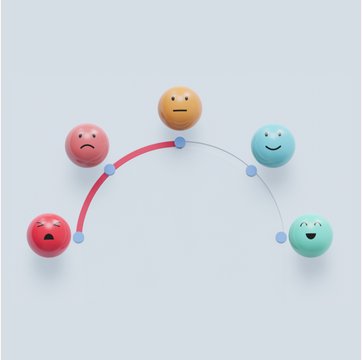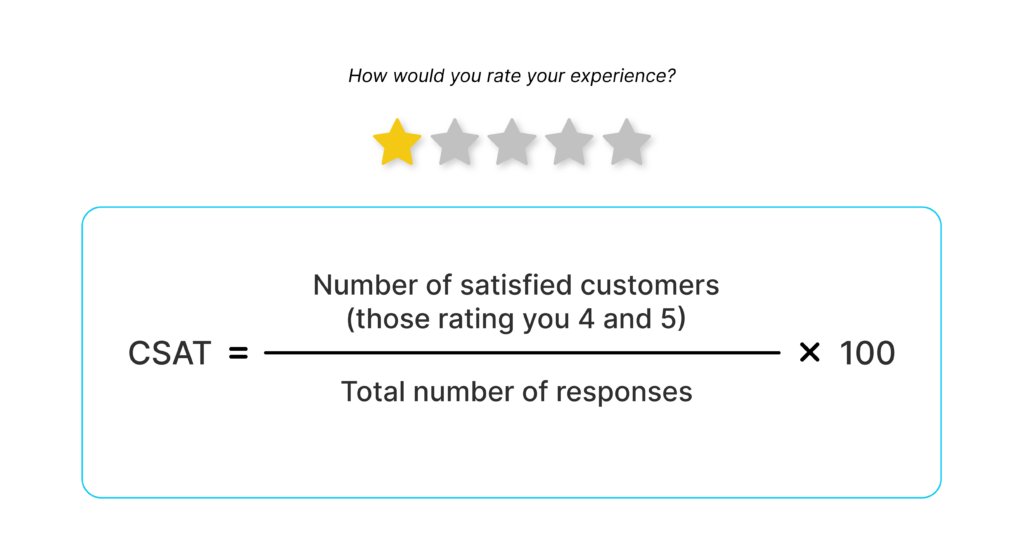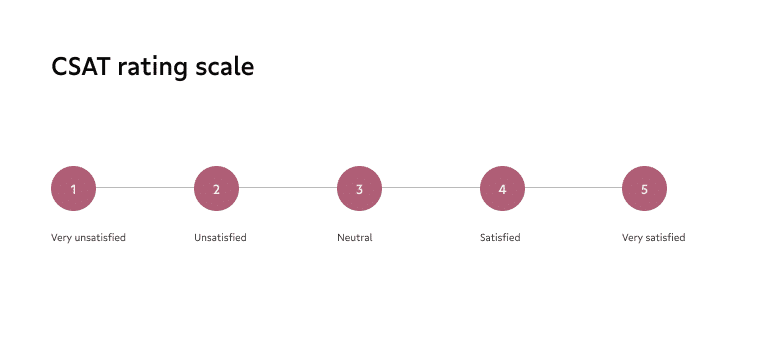What is a Customer Satisfaction Score? (And how to calculate it?)

Table of contents
Imagine QuickShop Online, a medium-sized e-commerce player, experiencing rapid growth and an expanding customer base. Their popularity soared initially due to a diverse product range and user-friendly platform. However, as their customer base grew, the QuickShop team faced a critical challenge: they began losing touch with customer sentiment.
Sales started to dip, and repeat purchases declined. Without a system to measure customer satisfaction scores (CSAT),QuickShop was navigating in the dark, unaware of the growing undercurrent of customer dissatisfaction related to issues like shipping delays and product quality. This lack of insight into customer satisfaction was directly impacting their bottom line, turning what was once a trajectory of growth into a struggle for market relevance.
Table of Contents
- What is a Customer Satisfaction Score?
- Benefits of Calculating a Customer Satisfaction Score
- How to calculate Customer Satisfaction Score?
- What is a Good Customer Satisfaction Score?
- When should you use CSAT?
- Pros and Cons of Customer Satisfaction Score
- Not to be treated as a standalone metric
By implementing a regular and robust system to measure CSAT, QuickShop could have kept its finger on the pulse of customer sentiment. How?
CSAT scores offer immediate and clear feedback – are customers happy with what you’re offering? Where do their pain points lie? Is there a particular aspect, like shipping or product quality, where the business consistently falls short?
By regularly calculating and analyzing your CSAT score, you can gain valuable insights into customer satisfaction levels and identify areas for improvement in your products or services.
What is a Customer Satisfaction Score?
The Customer Satisfaction Score, commonly abbreviated as CSAT, is a key performance indicator used by businesses to measure the satisfaction levels of their customers with a product, service, or experience.
It’s typically gauged through a simple survey question, such as “How satisfied were you with your experience?” The answers are often rated on a scale, for example, 1 to 5, where 1 might represent ‘very dissatisfied’ and 5 ‘very satisfied’.
Benefits of Calculating a Customer Satisfaction Score
CSAT scores aren’t just numbers; they are reflections of customer experiences and expectations. They can directly influence business strategies, guiding decisions on product development, customer service improvements, and overall business operations.
In a market where customer loyalty and satisfaction are paramount, understanding and leveraging CSAT data becomes a pivotal aspect of business success. These are the immediate benefits you gain from measuring customer satisfaction scores:
- Customer Retention: CSAT is a strong predictor of customer loyalty. A satisfied customer is more likely to return and use your services or products again. In a world where acquiring a new customer can cost significantly more than retaining an existing one, understanding and improving CSAT can be a cost-effective strategy.
- Service Improvement: Regular CSAT feedback provides real-time insights into your customers’ experiences. This information is invaluable for identifying areas of improvement, and enhancing service quality. It’s a direct feedback loop that helps businesses stay aligned with customer needs.
- Brand Reputation: High CSAT scores often translate to positive word-of-mouth. Satisfied customers can become advocates for your brand, sharing their positive experiences with others. This organic promotion is particularly valuable in today’s social media-driven market.
- Market Positioning: In competitive markets, a high CSAT can be a differentiator. It signals to potential customers that your business values customer experience and is committed to delivering quality. This can be a key factor in a customer’s decision-making process.
- Strategic Decision Making: CSAT data can inform broader business strategies. By understanding customer satisfaction trends, companies can make informed decisions about where to allocate resources, how to structure customer service teams, and where to focus marketing efforts.
In summary, CSAT is more than just a number. It’s a reflection of your business’s health, a marker of your customers’ happiness, and a guide for your strategic roadmap. No matter your industry, paying attention to CSAT can open doors to enhance customer relationships and drive business growth.
33 CSAT Survey Templates for Your Customer Support Team + Bonus Questions
How to calculate Customer Satisfaction Score?
The Customer Satisfaction Score (CSAT) is a measure of how satisfied customers are with a product, service, or experience. It’s a straightforward metric, calculated by asking customers to rate their satisfaction on a scale, typically ranging from very dissatisfied to very satisfied.
Here’s how to calculate the CSAT:
- Conduct a Survey: Ask customers to rate their satisfaction with your product, service, or a specific interaction. The question might be as simple as, “How satisfied were you with [product/service/experience]?” Provide a scale for them to respond, such as 1 to 5 or 1 to 10, where 1 could mean ‘very dissatisfied’ and 5 or 10 ‘very satisfied’.
- Collect Responses: Gather the responses from your survey. Only include responses that have given a rating for the satisfaction question.
- Calculate the Score: The basic formula to calculate CSAT is:

- Number of Satisfied Customers: This is the count of customers who gave a rating above a certain threshold. For instance, on a scale of 1 to 5, you might consider ratings of 4 and 5 as ‘satisfied’.
- Total Number of Respondents: This is the total number of people who responded to your survey.
- Convey in percentage: Multiply the result by 100 to express it as a percentage.
- Interpret the Score: A higher CSAT score indicates higher customer satisfaction. Industry benchmarks vary, so it’s useful to compare your score with relevant industry averages.
- Regular Monitoring: Regularly measure CSAT to track changes over time and after implementing any improvements.
Step-by-Step Guide to Creating Customer Surveys
It’s important to note that CSAT measures satisfaction at a specific point in time and is usually transactional. It’s most effective when combined with other metrics like Net Promoter Score (NPS) and Customer Effort Score (CES) for a comprehensive view of customer experience.
What is a Good Customer Satisfaction Score?
To understand what constitutes a good Customer Satisfaction Score (CSAT),it’s important to note that CSAT scores can vary significantly across different industries. Here’s a summary of average CSAT scores for various industries:
- Software and SaaS: A good CSAT score in the Software and SaaS industry typically ranges between 75% to 85%. However, it’s important to note that the CSAT score should be contextualized within the specific industry’s norms, company size, competitive landscape, and response rates to the survey. A score in the high 70s indicates that a company is competitive, but there is always room for improvement to stand out in the crowded SaaS market.
- eCommerce: In the E-commerce industry, the Customer Satisfaction Score (CSAT) has become a crucial metric for understanding and enhancing customer experiences. As of 2023, E-commerce companies have achieved an impressive average CSAT score of 80, up from 77 in 2022. This score places the E-commerce industry among the highest in customer satisfaction alongside software and finance sectors, underscoring the importance of providing a great experience both pre-sale and after-sale.
- Healthcare: According to their 2023 data on the healthcare industry, the customer satisfaction score for hospitals saw a slight increase from 2022. The ACSI (American Consumer Satisfaction Index) measures satisfaction across various industries, including health care. For 2023, the satisfaction score for hospitals increased to 74 from 71 in 2022, marking a 4% change. This measurement takes into account different aspects of patient care, such as outpatient care, inpatient care, and emergency room experiences. Similarly, the organization reports a record-high score of 76 out of 100 for health insurance satisfaction.
- Travel: In the travel industry, the American Customer Satisfaction Index (ACSI) Travel Study for 2022-2023 revealed improvements. Hotels experienced a 6% increase in guest satisfaction, with Hyatt and Marriott leading at an ACSI score of 80. The airline industry saw a modest 1% rise in customer satisfaction, with Alaska Airlines achieving the highest score of 81. In the car rental sector, there was a 1% increase in satisfaction, with Alamo topping the chart at 83. Online travel agencies also recorded a slight increase in user satisfaction, with smaller agencies and Expedia tying for the lead at a score of 79.
- Logistics: In the logistics industry, understanding Customer Satisfaction (CSAT) benchmarks is essential for gauging performance and setting targets. For the year 2023, the average CSAT score in the shipping sector was recorded at 77. This represents a 4% increase from 2022 when the score of 74.
For parcel delivery, another relevant sector in logistics, the average CSAT score was 34, with the lowest being 28 and the highest at 42. This suggests a relatively lower satisfaction level in this area compared to other industries, highlighting potential areas for improvement. - Education: For the education sector, the Customer Satisfaction (CSAT) benchmarks are insightful in understanding the level of satisfaction among students and other stakeholders. In 2023, the education industry recorded a CSAT score of around 69, according to data presented by Retently. This score indicates a moderate level of satisfaction among respondents in this sector.
Generally, CSAT scores ranging from 75 to 85 are considered ‘good’, but this varies depending on the industry, the company’s size, the competitors, and the survey response rates. It’s crucial to contextualize these scores within the specific industry and competitive landscape to understand their implications fully.
When should you use CSAT?
The Customer Satisfaction Score (CSAT) is a versatile tool, used across various points in the customer journey to gauge satisfaction with a product, service, or specific interaction. Here are some common scenarios when you should use CSAT:
- Post-Interaction Feedback: After a customer interacts with your support team, whether through a call, chat, or email, a CSAT survey can immediately assess how satisfied the customer was with the service provided.
- Post-Purchase Evaluations: Following a purchase, sending a CSAT survey helps gauge customer satisfaction with the buying process, product quality, and overall shopping experience.
- After Service or Product Delivery: Once a service is rendered or a product is delivered, CSAT can measure satisfaction with the delivery process, product installation, or service execution.
- During Periodic Check-Ins: Regularly scheduled CSAT surveys can help monitor ongoing customer satisfaction, providing insights into trends and long-term customer happiness.
- Following an Event or Training: After events like webinars, workshops, or training sessions, CSAT surveys can gather feedback on the event’s effectiveness, content quality, and presenter performance.
- After Resolving Customer Complaints: Once a customer issue or complaint is resolved, a CSAT survey can assess the resolution process’s effectiveness and the customer’s satisfaction with the outcome.
- Website and Digital Experience Feedback: For digital platforms, CSAT can be used to understand user satisfaction with website navigation, ease of use, content relevance, and online tools or resources.
- Product or Service Upgrades: After releasing new features, updates, or upgrades, CSAT can help measure how well these changes are received by the customers.
In all these cases, CSAT provides immediate feedback that can be used to make quick adjustments and improvements. It’s important to ensure that the timing of the survey is closely aligned with the interaction or experience being evaluated, as immediate feedback is typically more accurate and useful.
Maximize customer satisfaction with Hiver’s CSAT survey
Pros and Cons of Customer Satisfaction Score
The Customer Satisfaction Score (CSAT) is a common metric used by businesses to measure customer satisfaction with a product, service, or experience. Like any tool, it has its strengths and weaknesses:
Pros of Customer Satisfaction Score
- Simplicity and Clarity: An e-commerce website sends a post-purchase survey with a simple question: “On a scale of 1-5, how satisfied are you with your purchase experience?” This straightforward question makes it easy for customers to respond.
- Immediate Feedback: After a customer service call, a telecom company immediately sends a text message asking, “How satisfied were you with the support you received today?” enabling the company to quickly gauge and respond to customer satisfaction.
- Specificity: A software company releases a new feature and follows up with a CSAT survey specifically asking about the user experience with that new feature, thereby gaining specific feedback on that particular update.
- Customization: A hotel customizes its CSAT survey to focus on different aspects of a guest’s stay, such as check-in process, room quality, and dining experience, tailoring questions to each service area.
- Benchmarking: A restaurant chain uses CSAT to compare customer satisfaction across its various locations, enabling it to benchmark the performance of each restaurant against others in the chain.
Cons of Customer Satisfaction Score
- Limited Scope: A customer may rate a product highly in a CSAT survey right after a pleasing unboxing experience, but this doesn’t reflect their long-term satisfaction or usage experience with the product.
5 Commonly Misinterpreted Customer Service Metrics
- Response Bias: After a flight, an airline might receive CSAT responses primarily from passengers who had exceptionally good or bad experiences, potentially missing the opinions of the majority who had a neutral experience.
- Overemphasis on Short-Term Satisfaction: A retail store might focus on promotions and discounts to boost immediate CSAT scores, possibly neglecting longer-term strategies like product quality improvement or customer loyalty programs.
By considering these examples, businesses can better understand how to effectively use CSAT in conjunction with other metrics to gain a comprehensive view of customer satisfaction and experience.
Not to be treated as a standalone metric
As we conclude our discussion, it’s clear that while CSAT is an invaluable tool for measuring immediate customer satisfaction, it’s not without its limitations. Its simplicity and directness make it an excellent starting point for gauging customer sentiment following specific interactions or experiences.
However, the lack of depth in the feedback it provides means it’s best used as part of a broader strategy of customer experience measurement.
To truly understand and enhance the customer experience, it’s essential to complement CSAT with other metrics like Net Promoter Score (NPS) and Customer Effort Score (CES). These additional metrics can provide insights into customer loyalty, the effort required in customer interactions, and overall long-term satisfaction.


































